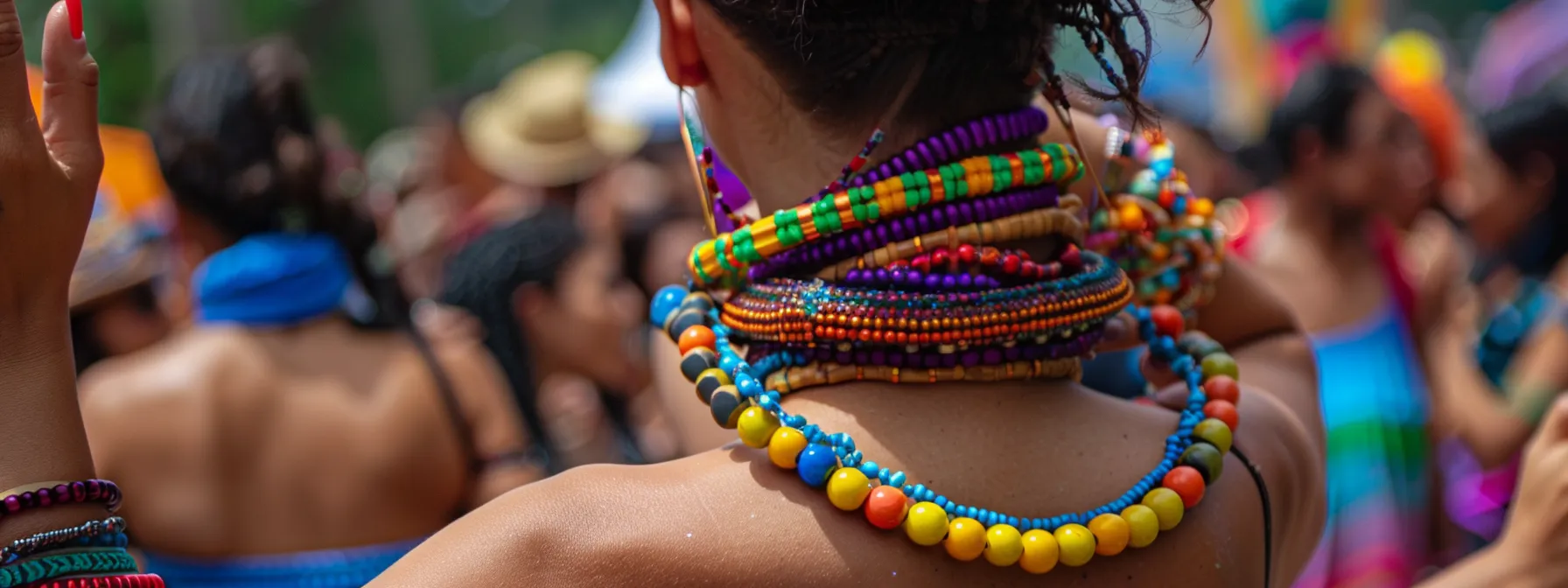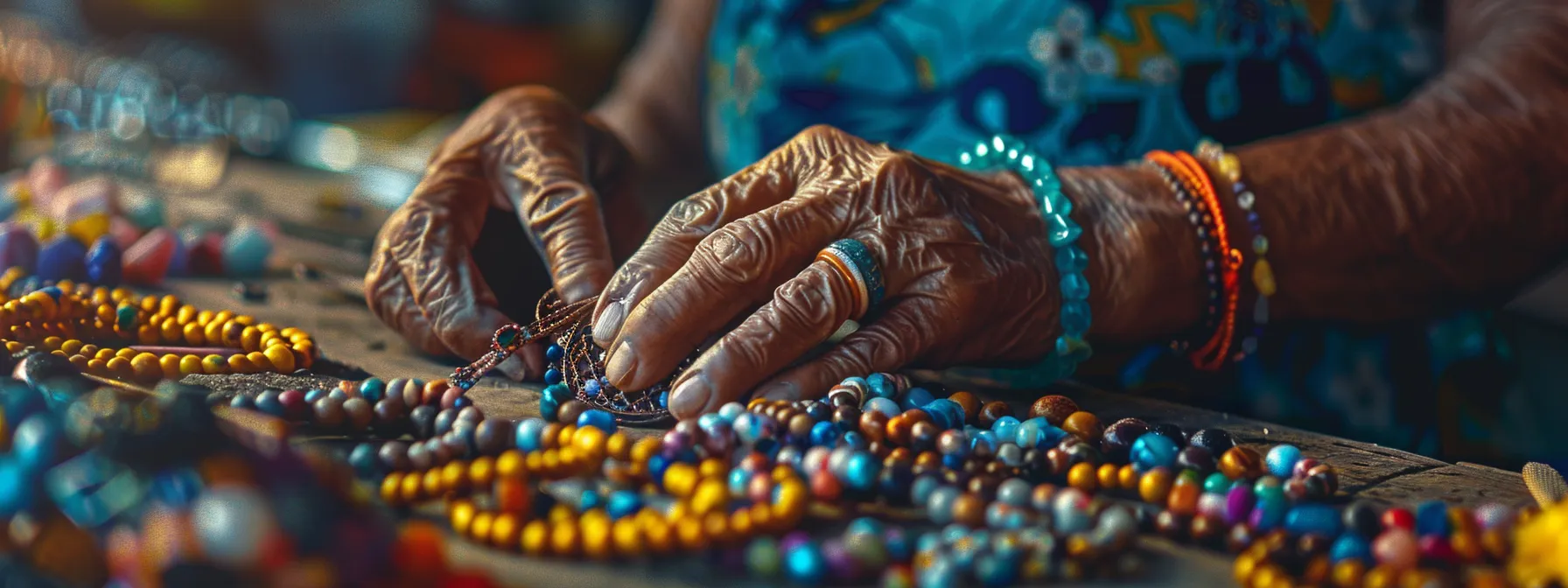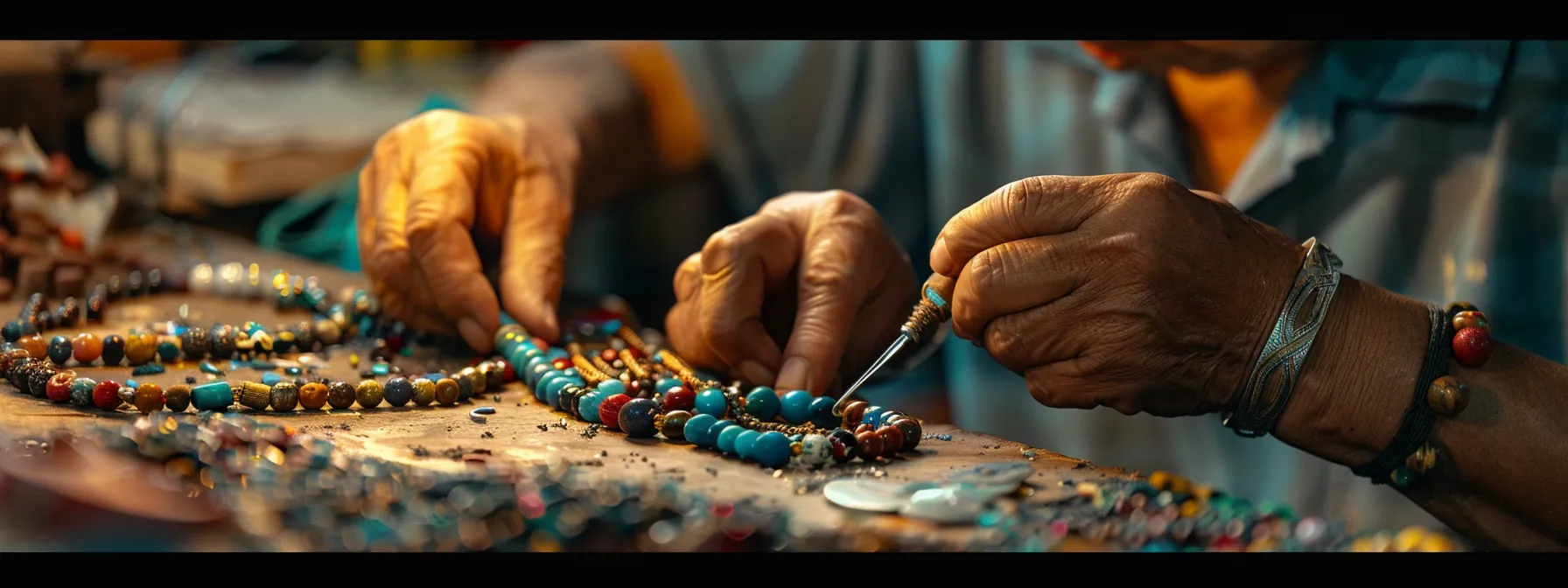Gemstones Therapy
Unveiling the History Behind Brazilian Gemstone Bracelets
Unveiling the History Behind Brazilian Gemstone Bracelets
Brazilian gemstone bracelets, adorned with vibrant stones like carnelian, offer a fascinating glimpse into the rich tapestry of history and culture. Imagine your future enhanced by the beauty of real gemstone bracelets, where each piece tells a story of craftsmanship and artistry woven through generations. The price of these exquisite accessories reflects their intrinsic value, making them not just adornments but symbols of heritage. Join us as we unravel the history behind these stunning creations, exploring their geological roots and cultural significance in Brazil. Keep reading to discover how the legacy of Brazilian gemstone bracelets continues to evolve and captivate hearts worldwide.
Key Takeaways
- Brazilian gemstone bracelets reflect a rich cultural history and artisanal craftsmanship through the ages
- Sustainable mining practices are essential for preserving both the environment and cultural heritage in Brazil
- Artisans blend traditional techniques with modern aesthetics to create unique and meaningful jewelry pieces
- Gemstones carry significant symbolism and mythology, enhancing their cultural and spiritual relevance
- Minas Gerais is the premier region for gemstone production, known for its stunning mineral diversity
Tracing the Ancient Roots of Brazilian Gemstone Bracelets

Cultivating an understanding of the history behind Brazilian gemstone bracelets reveals a fascinating journey through time. You will discover how ancient civilizations utilized real gemstone bracelets, particularly agate, long before European contact. During the Pre-Colombian Era, indigenous communities engaged in intricate techniques of gemstone crafting, creating pieces that not only showcased their artistry but also held cultural significance. The Portuguese colonization dramatically transformed the landscape of gemstone trade, introducing new methods and altering the trajectory of how these stones were perceived and valued. Additionally, the concepts of irradiation and weathering began to play a role in the enhancement of gemstones, giving new life and length to their uses. As you imagine your future explore these historical threads, you gain insight into the rich tapestry that informs the modern popularity of Brazilian gemstone bracelets.
Exploring Pre-Colombian Era Gemstone Use
In the Pre-Colombian era, indigenous groups in Brazil displayed remarkable craftsmanship as they utilized local resources including manganese, titanium, and aluminium, found in the unique pegmatite formations. Gemstones were meticulously shaped into stunning necklaces, often imbued with spiritual and cultural meaning, serving not just as adornment but also as symbols of identity and status. This rich tradition highlights the deep connection between these ancient communities and the natural beauty of their environment, laying the groundwork for the modern appreciation of gemstone jewelry.
The Impact of Portuguese Colonization on Gemstone Trade
The advent of Portuguese colonization brought significant changes to the gemstone trade in Brazil, introducing new techniques and perspectives. The exploration of local resources, such as corundum and demantoid, often led to the enhanced beauty of gemstones, with artisans learning to cut facets that accentuated their brilliance. As traders began to utilize granite and employ ultraviolet processes for treatments, these practices increased the allure of Brazilian gemstones in European markets, shaping the country’s future as a renowned source of exquisite jewelry.
Indigenous Techniques in Gemstone Crafting
Indigenous cultures in Brazil honed their skills in gemstone crafting through a deep understanding of mineralogy, allowing them to manipulate materials like aquamarine and other precious stones. Using traditional techniques, they harnessed the visible spectrum of colors within these minerals, often enhancing the aesthetic appeal of their creations. The vibrancy imparted by elements such as chromium not only celebrated their craftsmanship but also symbolized wealth and status within their communities.
As you journey through the vibrant history of Brazilian gemstone bracelets, prepare to be amazed by the natural wonders that lie beneath the surface. Discover how Brazil’s rich geological tapestry gives rise to some of the most sought-after gemstones in the world.
The Geological Marvel of Brazil’s Gemstone Riches

As you delve into the geological marvel of Brazil’s gemstone riches, you’ll uncover the diverse ecosystems that nurture these precious stones. Brazilian mines, particularly in Minas Gerais, are renowned for their unique crystal structures and the favorable conditions that create stunning geodes. This region serves as the gemstone heartland of Brazil, where minerals like topaz form under immense pressure over millennia, resulting in some of the most sought-after gemstones in the world. Transitioning from mine to market, you’ll appreciate the intricate journey these stones undergo, from their rough beginnings to becoming exquisite jewelry pieces that captivate admirers, reminiscent of the awe that ancient Greeks felt towards gemstones.
Discovering the Diverse Ecosystems of Brazilian Mines
Beneath Brazil’s vibrant surface lies a geological tapestry, rich in various minerals that stem from its diverse ecosystems. Chalcedony, a popular gemstone in jewelry making, reveals its beauty within the intricate formations found in Brazilian mines. Research into ancient metalworking techniques utilized by local artisans sheds light on how these communities skillfully transformed raw materials into sought-after pieces, mirroring the craftsmanship revered in ancient Rome.
- Brazil’s unique ecosystems support a wide variety of minerals essential for gemstone formation.
- Chalcedony is among the many stones that showcase the region’s geological wealth.
- Ancient artisans applied metalworking techniques developed over centuries to create exquisite jewelry.
- Research into these practices unveils the historical significance and cultural connections of gemstone use.
Minas Gerais: The Gemstone Heartland of Brazil
Minas Gerais stands out as Brazil’s premier gemstone-producing region, showcasing a wealth of natural resources that has captivated jewelry makers for centuries. You’ll find that among the dazzling variety of minerals, rubies and fluorite are particularly prized, reflecting both the stunning beauty and remarkable diversity of species within the region. The local artisans skillfully transform these gemstones into exquisite pieces, including ornate brooches that echo the artistry reminiscent of the Roman Empire.
- Minas Gerais hosts a stunning array of gemstones, including some of the most sought-after rubies.
- Fluorite, with its unique coloration, adds to the captivating assortment found in this region.
- Artists in Minas Gerais draw inspiration from both local heritage and global influences, creating pieces that are celebrated worldwide.
- The legacy of craftsmanship in Minas Gerais continues to thrive, much like the vibrant creativity of the Roman Empire.
From Mine to Market: The Journey of Brazilian Gemstones
The journey of Brazilian gemstones from mine to market showcases a blend of natural wonder and human creativity. Once extracted, stones like jasper undergo meticulous processing, often inspired by techniques displayed at institutions such as the Smithsonian Institution, which highlight the artistry required in gemstone crafting. As these crystals make their way to artisans, they are transformed into exquisite jewelry that reflects not only Brazil’s geological diversity but also influences from global sources, including the distinct styles emerging from Zambia.
Brazil’s breathtaking gemstones not only dazzle the eyes but also weave rich cultural narratives. Dive deeper as we explore how these stunning treasures take on vibrant meanings in the art of bracelet-making across the nation.
Cultural Significance of Gemstone Bracelets in Brazil

As you delve into the cultural significance of gemstone bracelets in Brazil, you’ll uncover a rich tapestry of symbolism and mythology intertwined with these adornments. Each gemstone, from the vibrant hues of malachite to the deep violet tones of amethyst, carries its own legend, often seen as a protective talisman connecting the wearer to ancient traditions. Bracelets made from these stones frequently adorn participants in Brazilian festivals, where the use of gemstone jewelry enhances the vibrancy of the celebration and showcases the artistry of local artisans. Moreover, the role of gemstones extends into Brazil’s spiritual practices, where their connection to the earth, often rooted in igneous rock formations and rich ore deposits, serves as a reminder of the natural world’s profound influence on personal and communal beliefs.
Symbolism and Mythology Surrounding Brazilian Gemstones
Brazilian gemstones like turquoise hold a deep connection to the cultural narratives and spiritual beliefs of the region. The beauty of these stones is often likened to that of revered gems from ancient Greece, where craftsmanship was meticulous, and every carat revealed a hidden story. Made primarily of silicon, these gems are seen not only as adornments but also as symbols of protection and power, connecting wearers to their ancestry and the Earth’s profound energies.
Gemstone Bracelets in Brazilian Festivals and Traditions
In Brazilian festivals, gemstone bracelets play a significant role in showcasing the rich culture and traditions of the region. Adorned with vibrant stones, each piece often features copper accents that symbolize strength and connection to the earth, while serving as a cultural statement. Whether worn as a personal birthstone or a statement piece, these bracelets contribute to the celebratory atmosphere, adorning not only wrists but sometimes ears, amplifying the aesthetic appeal of the festive attire.
The Role of Gemstones in Brazil’s Spiritual Practices
In Brazil, gemstones serve not only as adornments but play a pivotal role in spiritual practices, where each stone’s unique characteristics, such as the piezoelectricity of elbaite or the fluorescence of emerald, carry distinct meanings. The refractive index of a stone can enhance its perceived beauty and allure, drawing individuals toward its healing energies and symbolic significance. By incorporating these powerful stones into rituals and daily practices, you connect with their natural properties, reinforcing your relationship with the earth and embracing the spiritual essence they embody.
Amidst rich traditions, Brazilian gemstone bracelets are reclaiming their spot in the spotlight. A vibrant revival is underway, energizing artisans and enthusiasts alike, as these stunning pieces capture a new generation’s imagination.
The Renaissance of Brazilian Gemstone Bracelets

The 20th century marked a significant revival in the artisanal craftsmanship of Brazilian gemstone bracelets, with new artisans emerging who celebrated traditional techniques while incorporating modern aesthetics. As contemporary makers explore various silicate minerals, such as zircon, they experiment with unique characteristics influenced by elements such as iron and vanadium, enhancing the visual appeal of their creations. The distinct cleavage patterns of these gemstones not only showcase their natural beauty but also reflect the creativity and skills of these artisans. Today, the impact of Brazilian gemstone bracelets extends beyond local markets, influencing global fashion trends and earning a place in the hearts of jewelry enthusiasts worldwide.
The 20th Century Revival of Artisanal Gemstone Craftsmanship
The revival of artisanal gemstone craftsmanship in Brazil during the 20th century reflects a fusion of traditional techniques with modern creative expressions. Artisans began to embrace diverse methods, including heat treating to enhance gemstone colors and clarity, gaining inspiration from global trends, such as intricate embroidery styles observed from the Czech Republic. The resulting pieces, often resembling ancient amulets, featured opals and other stones, symbolizing both beauty and deeper spiritual connections.
- Rediscovery of traditional techniques enhanced with modern aesthetics.
- Integration of global influences, including Czech Republic embroidery themes.
- Use of heat treating to elevate gemstone appearances.
- Creation of pieces that evoke the design of ancient amulets.
- Incorporation of opal, enriching the symbolism and appeal of jewelry.
Contemporary Makers and Their Techniques
Contemporary makers in regions like Rio Grande do Sul are pushing the boundaries of gemstone jewelry through innovative techniques and an intricate understanding of geology. You will find artisans blending traditional lapidary practices with modern materials such as resin to create unique pieces that reflect both innovation and heritage. By studying resources from institutions like the American Museum of Natural History, these creators are inspired to explore new facets of design and craftsmanship, enriching the landscape of Brazilian gemstone bracelets.
The Influence of Brazilian Gemstone Bracelets on Global Fashion
Brazilian gemstone bracelets have transcended local appreciation to significantly impact global fashion, showcasing the allure of stones such as jade, chrysoberyl, and amber. Designers worldwide draw inspiration from the intricate craftsmanship that echoes the luxurious styles reminiscent of the Byzantine Empire, integrating these unique gemstones into contemporary jewelry collections. This fusion of heritage and modernity allows you to wear pieces that not only reflect Brazil’s rich geological diversity but also resonate with international aesthetic trends.
Brazil’s vibrant gem industry is more than just a craft; it’s a harmonious blend of art and nature. Let’s dive into the renowned gemstones that elevate bracelet making to a stunning art form.
Renowned Brazilian Gemstones in Bracelet Making

As you delve into the world of Brazilian gemstone bracelets, you encounter a vibrant array of stones that not only beautify but also carry rich histories and meanings. Amethyst, revered since the days of Queen Victoria, transcends mere aesthetics, offering a deep spiritual connection that resonates with many. Meanwhile, tourmaline showcases a captivating spectrum of colors, often referred to as the “rainbow stone of Brazil,” thanks to its unique ability to be found in a prism of shades. Citrine and topaz, reminiscent of the warm Brazilian sunshine, bring brightness and positivity to any piece, appealing to those who appreciate their gemological significance. Together, these stones create a striking combination in bracelet design, often enhanced with intricate wire techniques that highlight their natural beauty while echoing the historical practices that date back to regions as far as Siberia.
Amethyst: Beyond Beauty to Deep Spiritual Connection
As you explore amethyst, you’ll find that it transcends mere aesthetics, revealing a deep spiritual connection cherished by many in South America. Not only is its vivid purple hue captivating, but amethyst also exhibits unique properties such as pleochroism, where the color shifts depending on the angle of light, creating a dynamic visual experience. With a relatively low melting point compared to other gemstones like garnet, it allows for intricate inclusions that enhance its beauty and symbolic significance, making it a treasured choice for bracelets that embody both style and spirituality.
Tourmaline: The Rainbow Stone of Brazil
Tourmaline, often hailed as the “Rainbow Stone of Brazil,” captivates jewelry enthusiasts with its exceptional variety of colors and remarkable properties. This dynamic gemstone, a complex boron silicate, showcases hues ranging from deep greens to striking pinks, thanks to its unique crystalline structure that includes various elements like iron and manganese. As you explore the significance of tourmaline, you may recall stories of how its captivating colors inspired both emperors and artisans, leading to its remarkable presence in museums, such as the National Museum of Natural History, where its beauty continues to be celebrated across the globe, including bustling markets in New York City.
- Tourmaline‘s diverse color spectrum is due to the inclusion of various elements within its quartz structure.
- It has a notable history, being embraced by emperors and revered craftsmen alike.
- This gemstone‘s unique attributes make it a symbol of creativity and richness in Brazilian jewelry.
- Visitors to institutions like the National Museum of Natural History admire the exquisite formations of tourmaline and understand its geology rooted deep within the Earth’s crust.
Citrine and Topaz: Illuminating Brazilian Sunshine
Citrine and topaz embody the vibrant essence of Brazilian sunshine, making them beloved choices in bracelet design. Sourced primarily from the rich landscapes of Minas Gerais, these gemstones not only offer stunning hues but also carry significant cultural and historical weight in Latin traditions. Often found alongside the renowned paraíba tourmaline and the versatile beryl family, citrine and topaz enhance any collection, serving as a testament to Brazil’s remarkable gemstone heritage.
Brazilian gemstones not only captivate with their beauty but also carry a rich history that has shaped the art of bracelet making. It’s time to delve into the efforts that ensure these exquisite creations continue to thrive for generations to come.
Preserving the Legacy of Brazilian Gemstone Bracelets

As you consider the ongoing legacy of Brazilian gemstone bracelets, it becomes clear that sustainable mining practices play a crucial role in ensuring the future of this vibrant industry. Modern artisans are increasingly aware of the environmental impacts associated with extracting valuable stones like amethyst and silicon dioxide varieties. By adopting more responsible methods, they help preserve natural resources while crafting exquisite pieces that showcase their unique artistry. The delicate balance between traditional techniques and innovative approaches ensures that the craftsmanship passed down through generations remains relevant today. This fusion not only maintains cultural significance but also appeals to contemporary consumers seeking authentic and ethically produced jewelry. Everything from the intricate beads to pyramid-shaped designs reflects the commitment to sustainability and heritage in the evolving landscape of gemstone jewelry making.
The Role of Sustainable Mining Practices
Sustainable mining practices in Brazil are essential for preserving the legacy of gemstone craftsmanship. As you delve into this topic, consider how responsible extraction methods are not only vital for the environment but also for the vibrancy of cultural traditions. Adopting these techniques helps ensure that valuable stones, measured on the Mohs scale, can be beautifully shaped and engraved for diverse uses, including stunning wedding rings, all while reflecting the expertise recognized by the Gemological Institute of America.
Artisanal Craftsmanship and Its Future
The future of artisanal craftsmanship in Brazilian gemstone bracelets is bright, fueled by a regeneration of interest in unique hues and sustainable practices. Artisans are not only preserving traditional techniques but are also inspired by contemporary trends, allowing them to incorporate modern elements, such as platinum accents, which enhance the intricate beauty of their creations. As they innovate while honoring their heritage, these skilled craftsmen ensure that the legacy of Brazilian gemstone jewelry continues to thrive in an ever-changing market.
Bridging Traditional and Modern Techniques in Jewelry Making
In your journey through the world of jewelry making, you will encounter a striking blend of traditional craftsmanship and modern innovation that defines the creation of Brazilian gemstone bracelets. Artisans today are incorporating contemporary techniques such as CAD (computer-aided design) alongside age-old methods, allowing for precision while retaining the rich heritage associated with each piece. This fusion not only enhances the visual appeal of the jewelry but also ensures that the artisanal skills passed down through generations continue to thrive in a modern market.



